An Eighteen Year Temporal Trends Analysis of Bifenthrin Sediment Concentrations in California Waterbodies
Abstract
:1. Introduction
2. Methods
3. Results and Discussion
4. Conclusions
Author Contributions
Funding
Acknowledgments
Conflicts of Interest
References
- Shamim, M.T.; Hoffmann, M.D.; Melendez, J.; Ruhman, M.A. Ecological risk characterization for synthetic pyrethroids. In Synthetic Pyrethroid Occurrence and Behavior in Aquatic Environments; Gan, J., Spurlock, F., Hendley, P., Weston, D., Eds.; American Chemical Society: Washington, DC, USA, 2008; pp. 257–309. [Google Scholar]
- Spurlock, F.; Lee, M. Synthetic pyrethroid use patterns, properties, and environmental effects. In Synthetic Pyrethroid Occurrence and Behavior in Aquatic Environments; Gan, J., Spurlock, F., Hendley, P., Weston, D., Eds.; American Chemical Society: Washington, DC, USA, 2008; pp. 3–25. [Google Scholar]
- Aquatic Science Center. The Pulse of the Delta: Monitoring and Managing Water Quality in the Sacramento-San Joaquin Delta. Rethinking Water Quality Monitoring. Contribution 630; Aquatic Science Center: Oakland, CA, USA, 2012. [Google Scholar]
- Laskowski, D.A. Physical and chemical properties of pyrethroids. Rev. Environ. Contam. Toxicol. 2002, 174, 49–170. [Google Scholar] [PubMed]
- Weston, D.P.; Holmes, R.W.; You, J.; Lydy, M.J. Aquatic toxicity due to residential use of pyrethroid insecticides. Environ. Sci. Technol. 2005, 39, 9778–9784. [Google Scholar] [CrossRef] [PubMed]
- Budd, R.; Wang, D.; Ensminger, M.; Phillips, B. An evaluation of temporal and spatial trends of pyrethroid concentrations in California water bodies. Sci. Total Environ. 2020. [Google Scholar] [CrossRef]
- Fojut, T.L.; Tjeerdema, R.S. Water Quality Criteria for Bifenthrin; Updated report May 2015; Central Valley Regional Water Quality Control Board: Rancho Cordova, CA, USA, 2015.
- Hall, L.W., Jr.; Alden, R.W., III; Anderson, R.D.; Killen, W.D. Ranking the importance of benthic metrics and environmental stressors from over a decade of bioassessment multiple stressor studies in five California waterbodies. J. Environ. Sci. Health A 2019. [Google Scholar] [CrossRef] [PubMed]
- Gibbons, R.D.; Coleman, D.E. Statistical Methods for Detection and Quantification of Environmental Contamination; John Wiley and Sons: New York, NY, USA, 2001. [Google Scholar]
- McNichols, R.J.; Davis, C.B. Statistical issues and problems in groundwater detection monitoring at hazardous waste facilities. Ground Water Monit. Rev. 1988, 8, 135–150. [Google Scholar] [CrossRef]
- Karickoff, S.W.; Brown, D.S.; Scott, T.A. Sorption of hydrophobic pollutants on natural sediments. Water Res. 1979, 13, 241–248. [Google Scholar] [CrossRef]
- Hall, L.W., Jr.; Anderson, R.D. Temporal Trends Analysis of Bifenthrin Sediment and Water Concentrations from Sites in the CEDEN Data Set (Task 4 in 2020 FMC Scope of Work); Report Prepared for FMC Corporation by the University of Maryland, College of Agriculture and Natural Resources, Agricultural Experiment Station; Wye Research and Education Center: Queenstown, MD, USA, 2020. [Google Scholar]
- Amweg, E.L.; Weston, D.P.; You, J.; Lydy, M.J. Pyrethroid insecticides and sediment toxicity in urban creeks for California and Tennessee. Environ. Sci. Technol. 2006, 40, 1700–1706. [Google Scholar] [CrossRef] [PubMed]
- Hirsch, R.M.; Slack, J.R.; Smith, R.A. Techniques of trend analysis for monthly water quality data. Water Resour. Res. 1982, 18, 107–121. [Google Scholar] [CrossRef] [Green Version]
- Hall, L.W., Jr.; Anderson, R.D. Historical trends analysis of 2004 to 2009 toxicity and pesticide data for California’s Central Valley. J. Environ. Sci. Health A 2012, 47, 801–811. [Google Scholar] [CrossRef] [PubMed]
- U.S. Environmental Protection Agency. Method 808 1BM, Organochlorine Pesticides by Gas Chromatography, Revision 1 Modified (Appendix IV); United States Environmental Protection Agency: Washington, DC, USA, 1996.
- Hall, L.W., Jr.; Perry, E.; Anderson, R.D.; Killen, W.D. A comparison of different statistical methods for addressing censored left data in temporal trends analysis of pyrethroids in a California stream. Rev. Arch. Env. Contam. Toxicol. 2020, in press. [Google Scholar]
- Hall, L.W., Jr.; Killen, W.D.; Anderson, R.D.; Alden, R.W., III. An Assessment of Benthic Communities with Concurrent Physical Habitat, Pryethroids, and Metals Analysis in Pleasant Grove Creek in 2019 and 2006-2019; Final Report for the Pyrethroid Working Group prepared by the University of Maryland; Wye Research and Education Center: Queenstown, MD, USA, 2019. [Google Scholar]
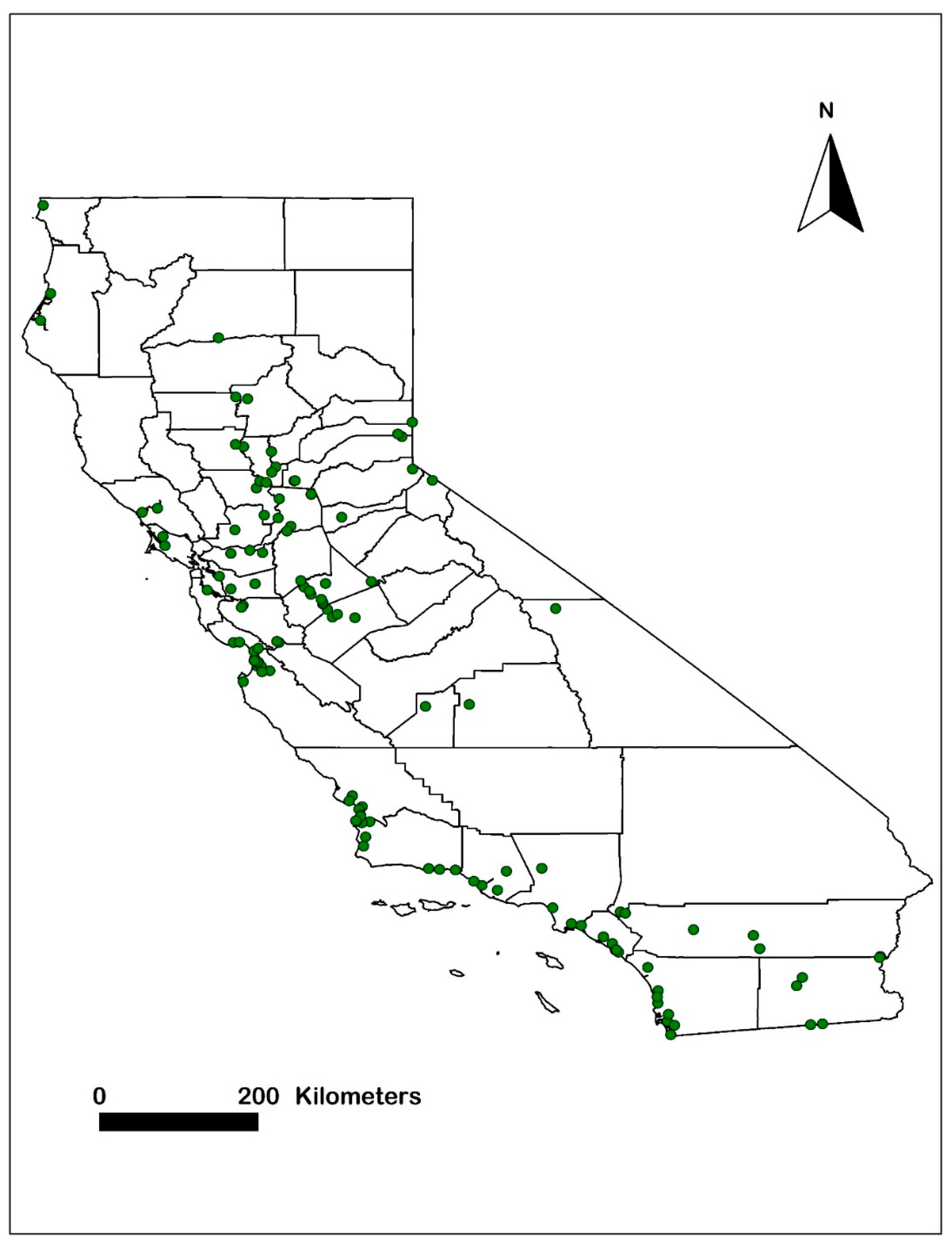
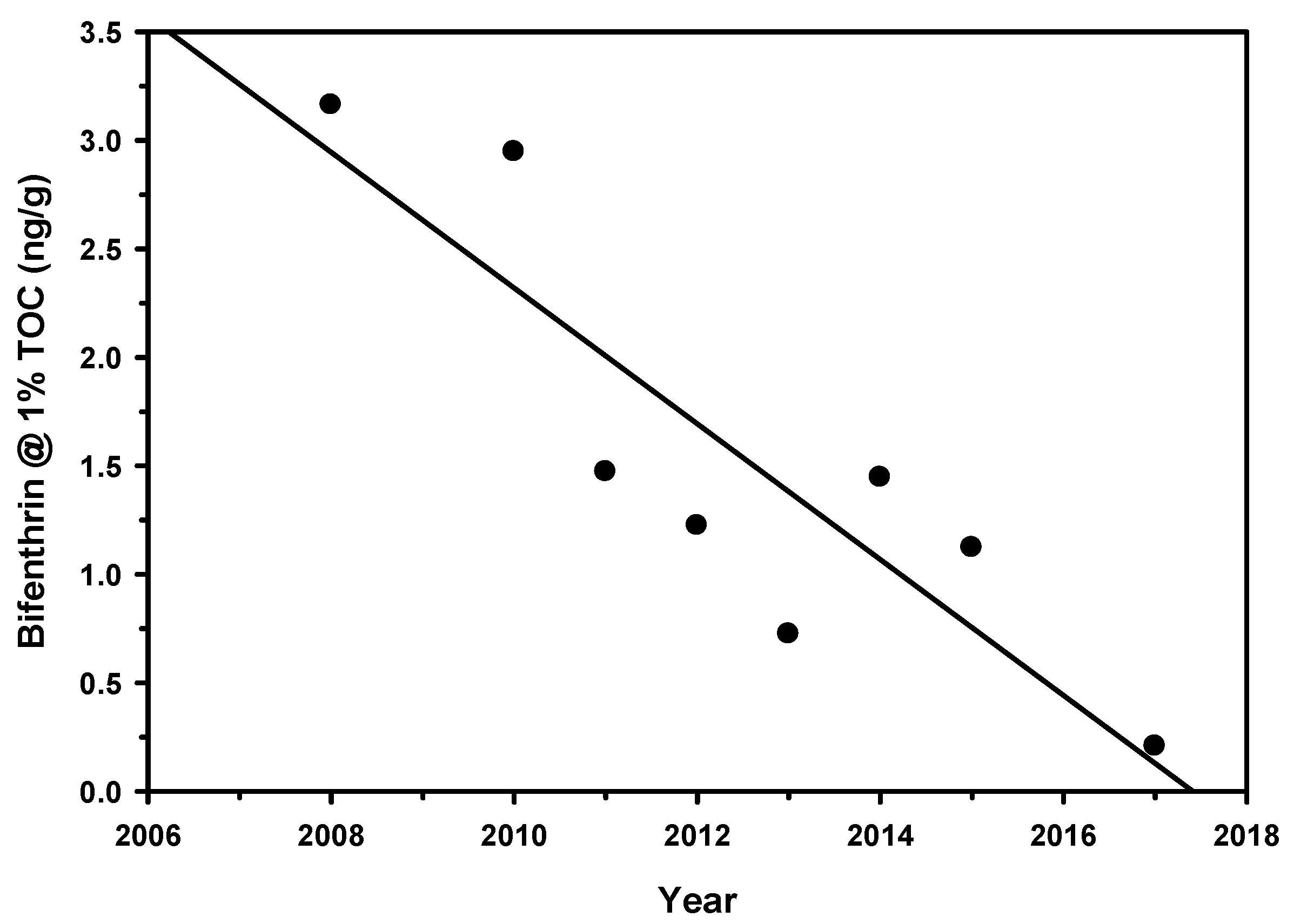
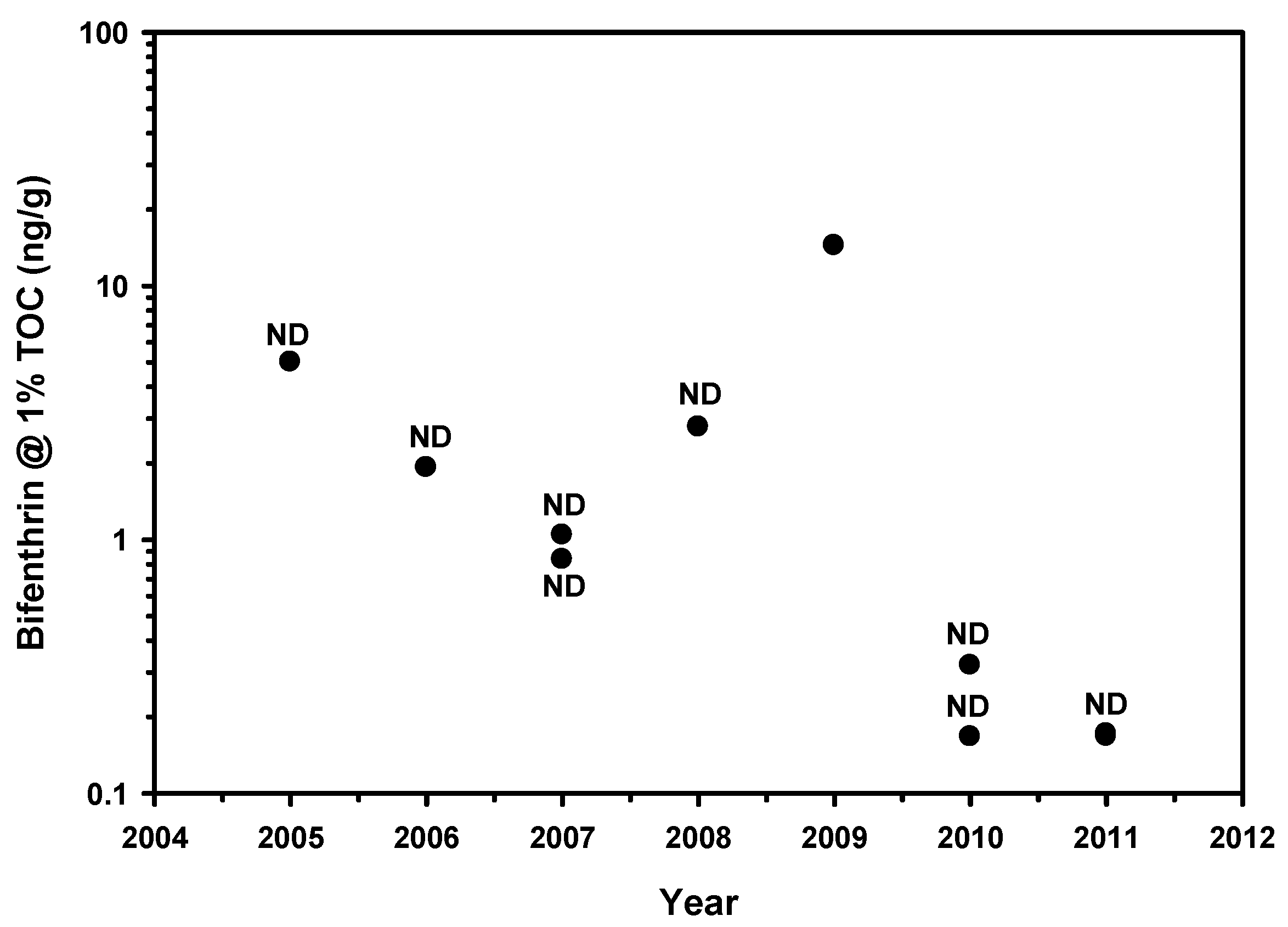
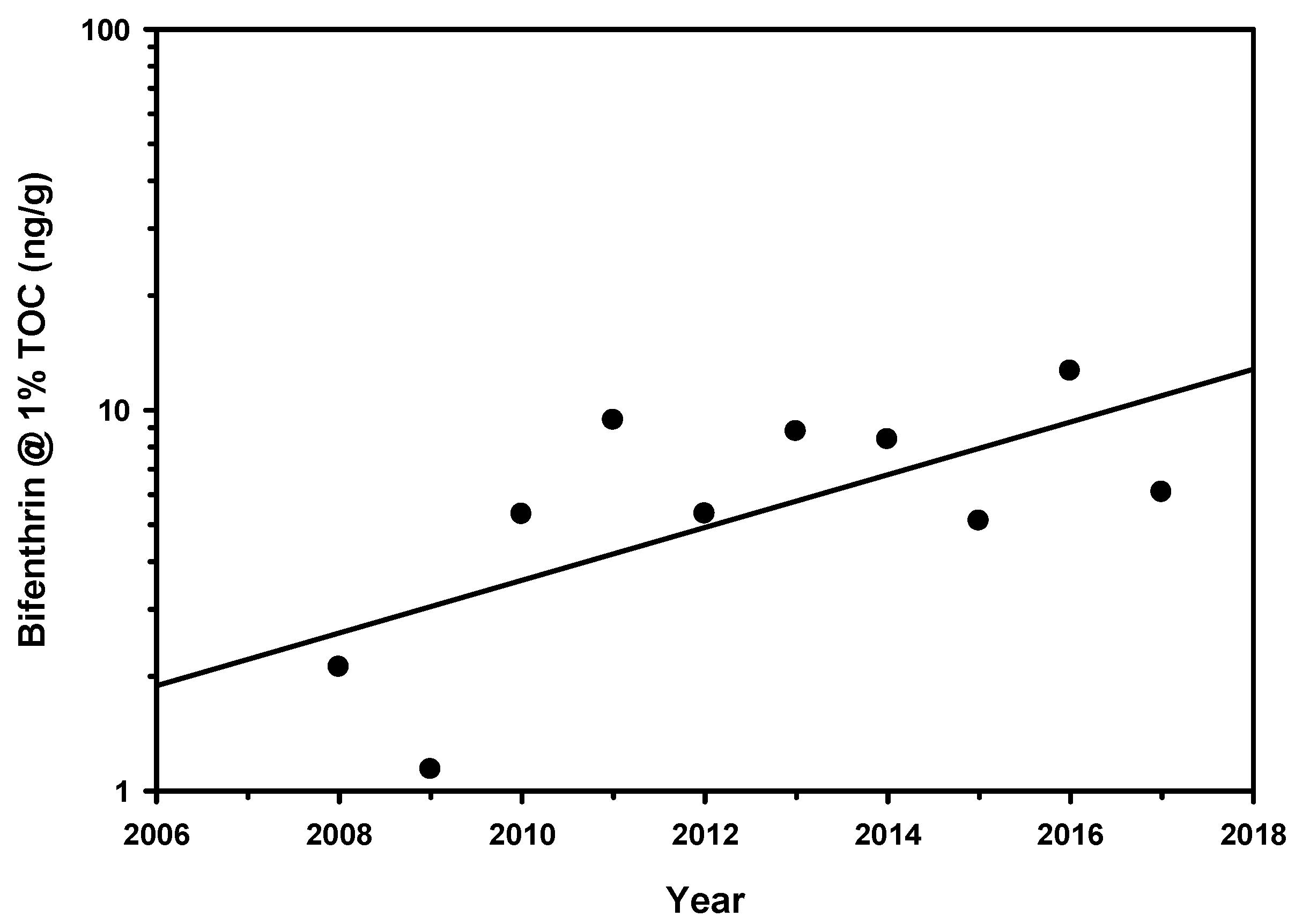
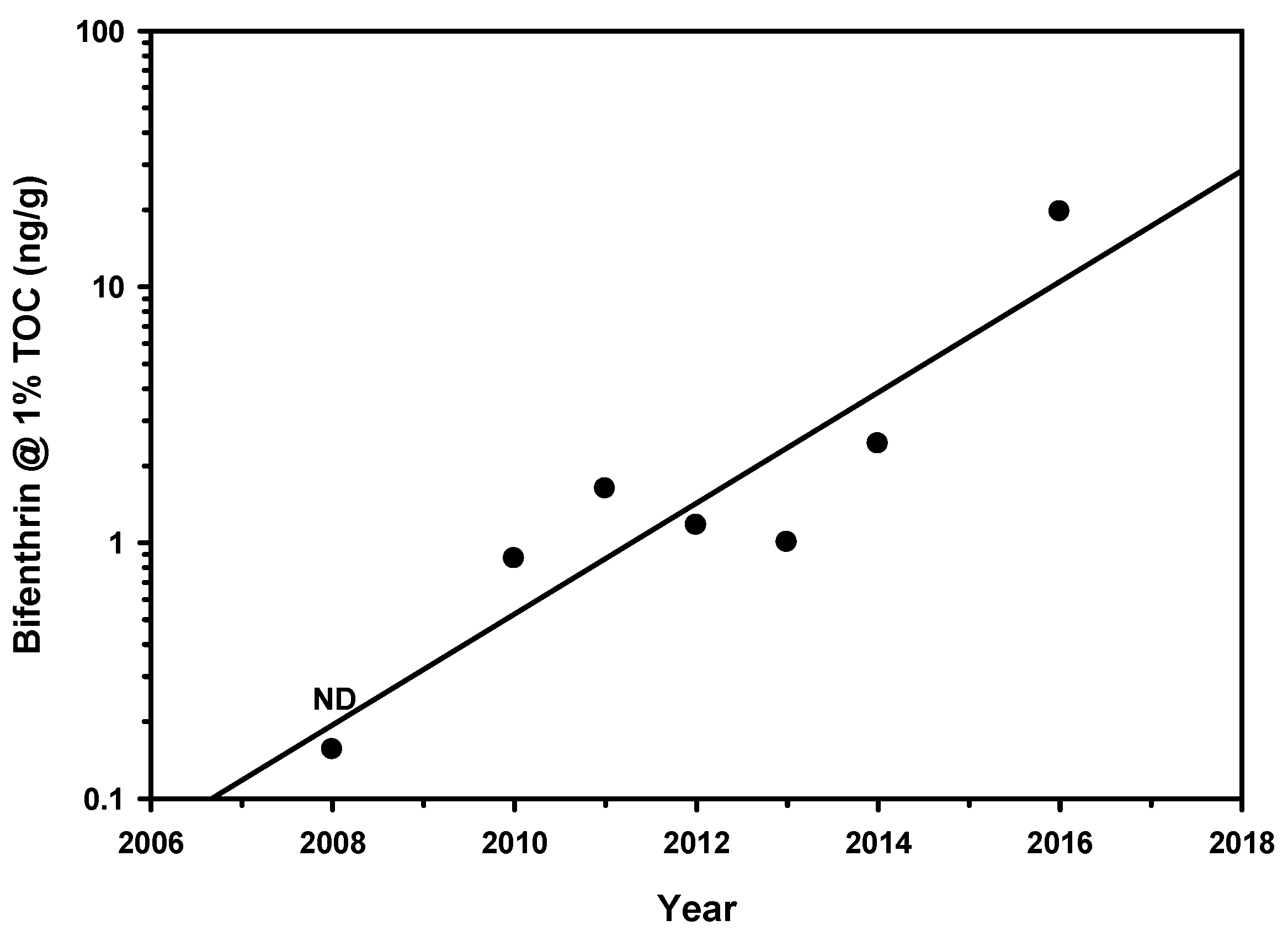
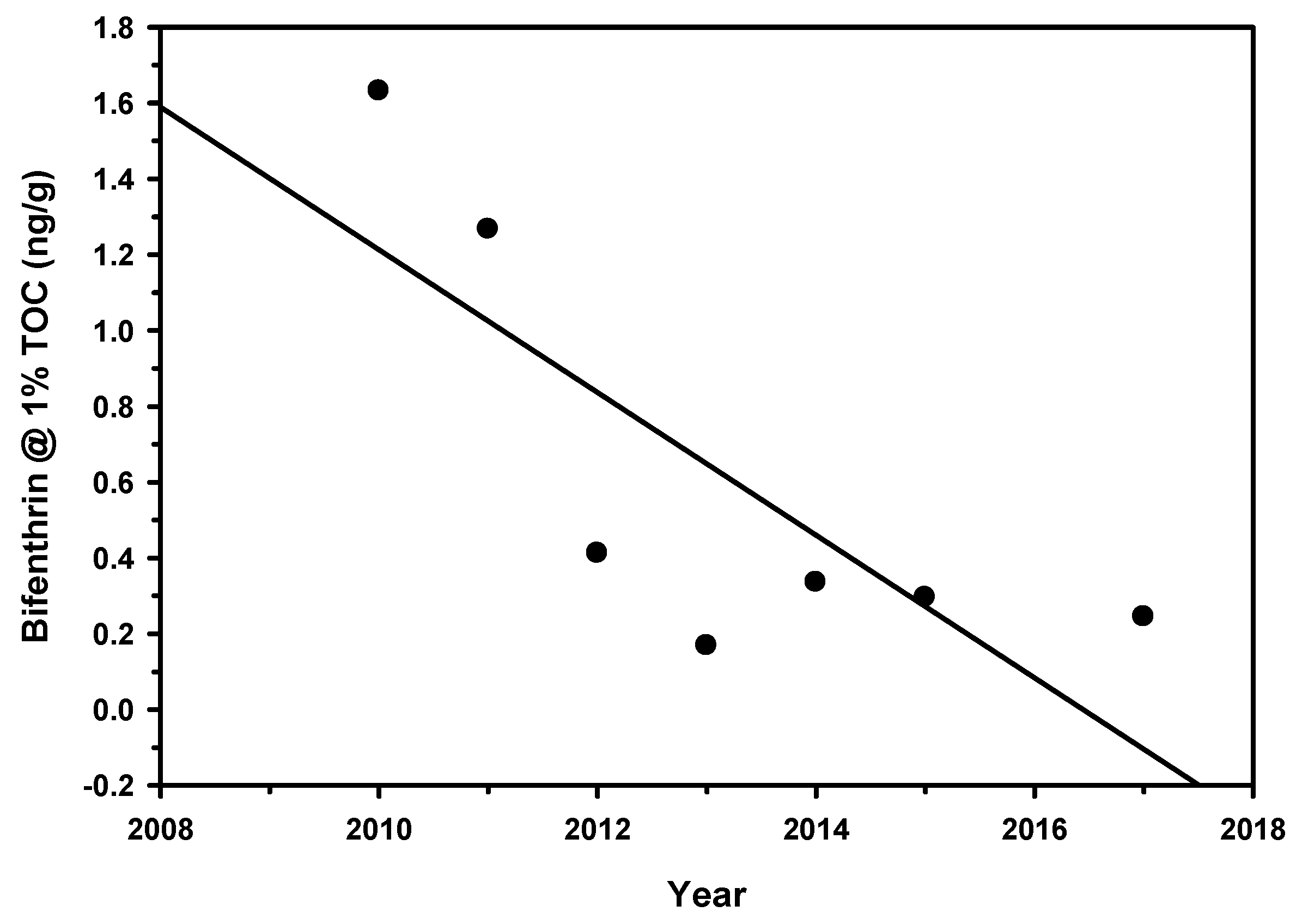
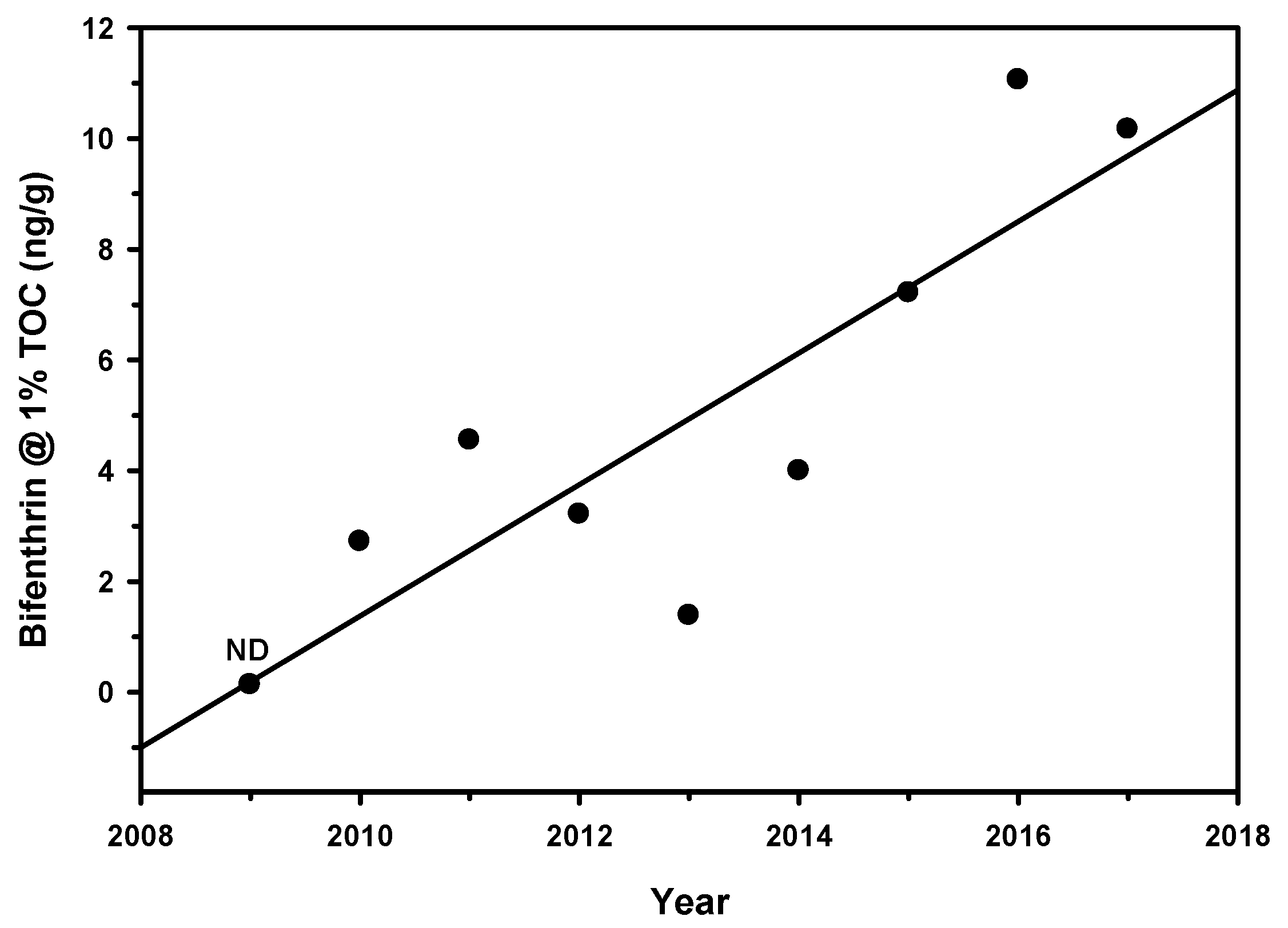

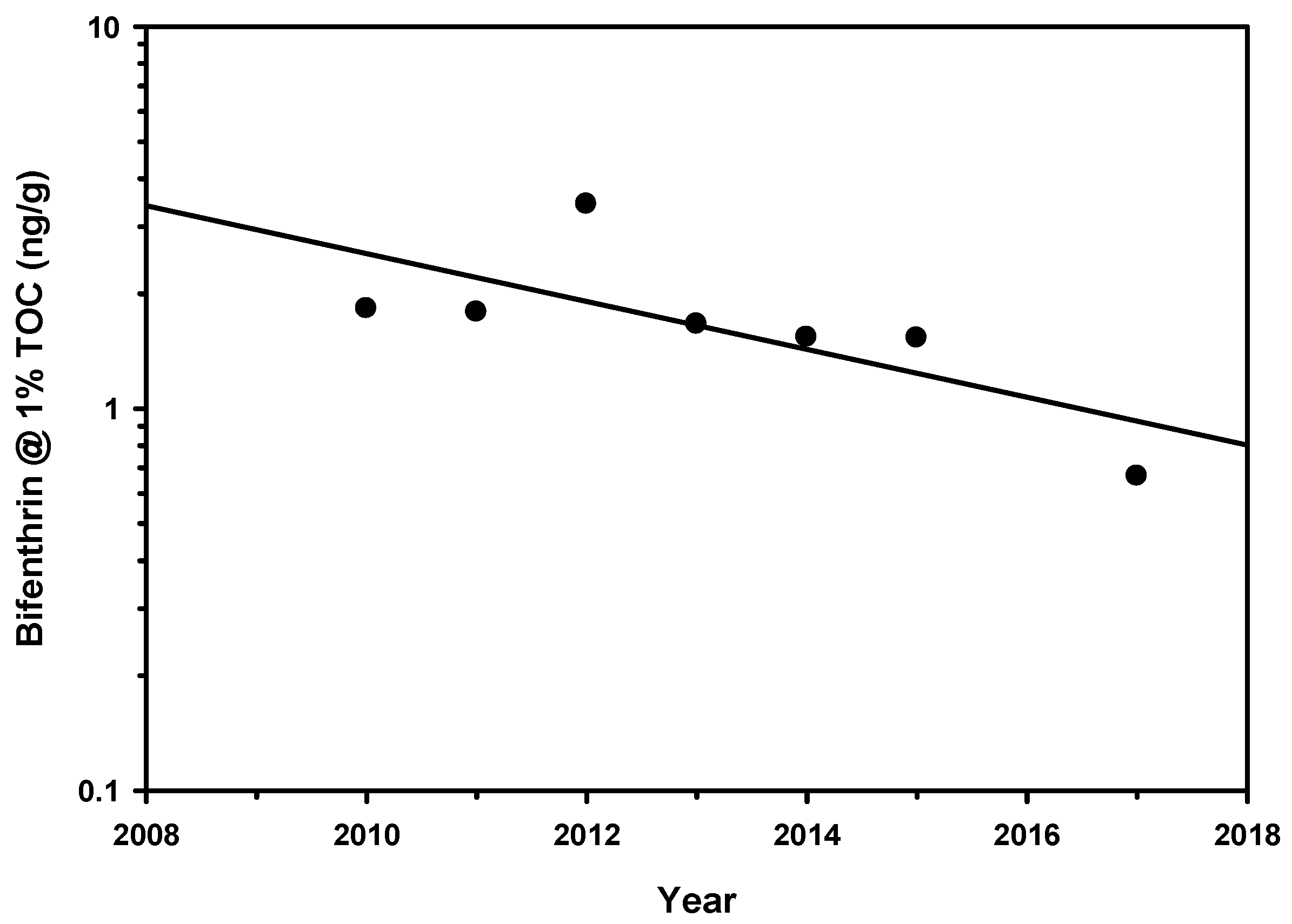
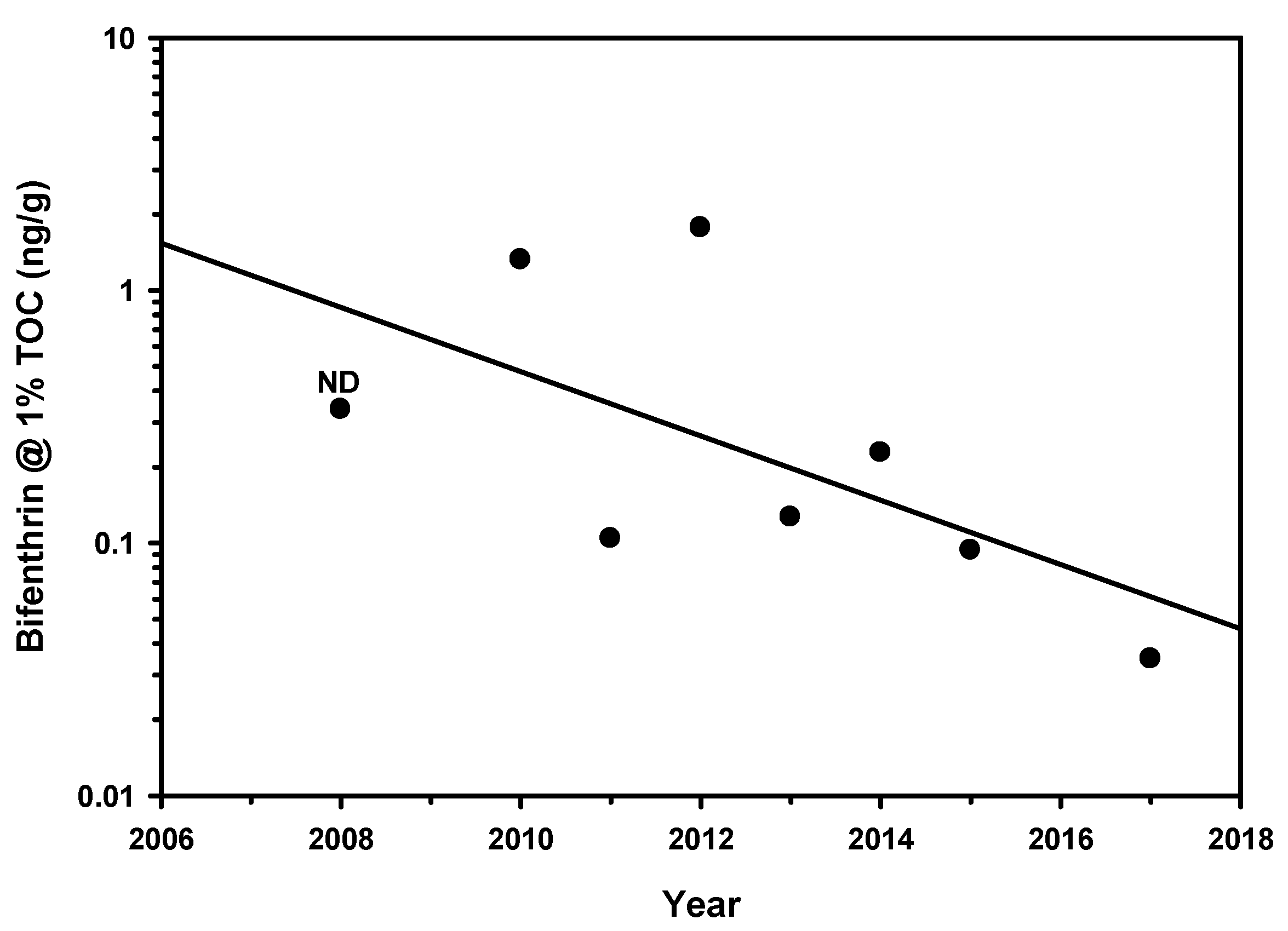
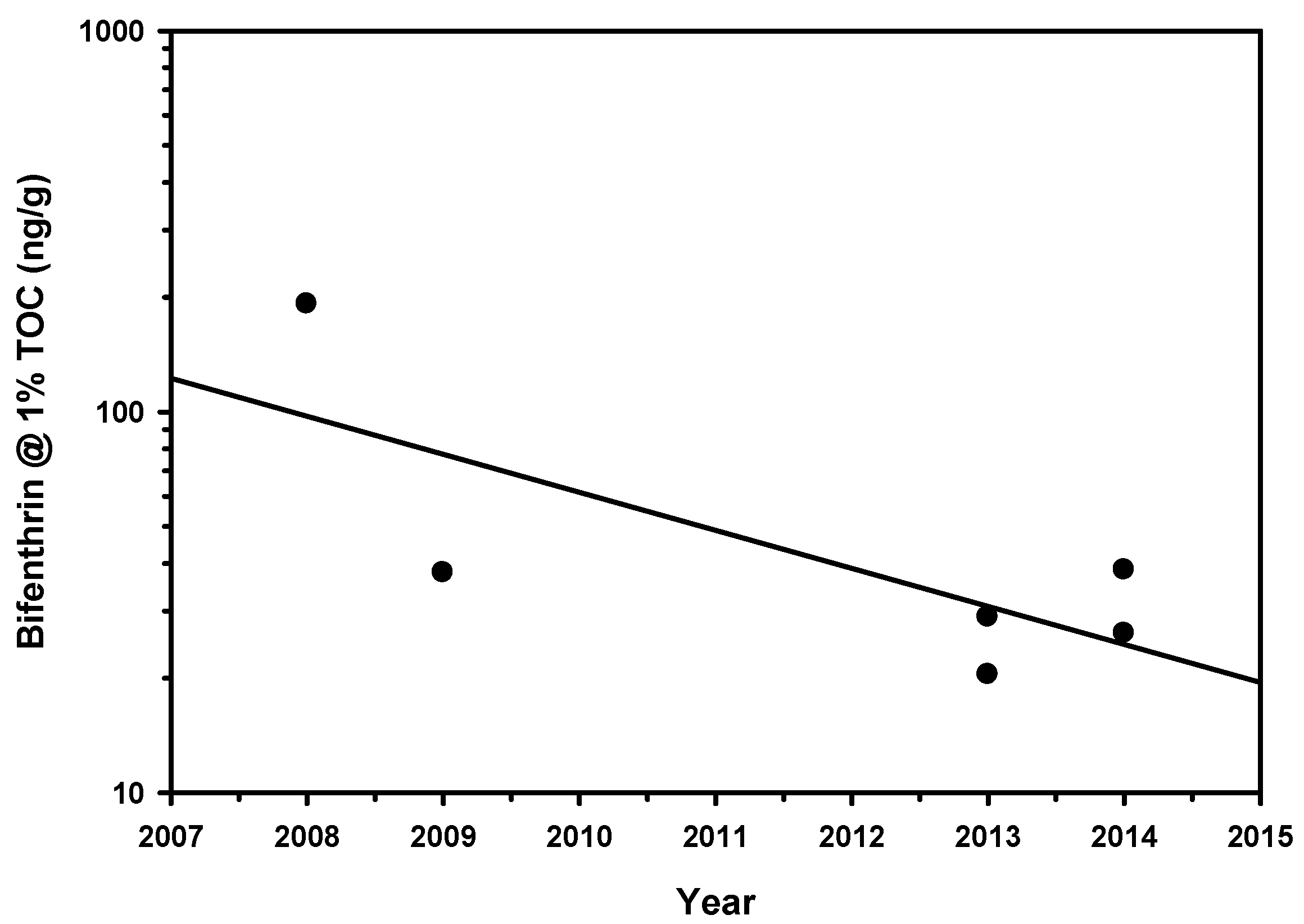

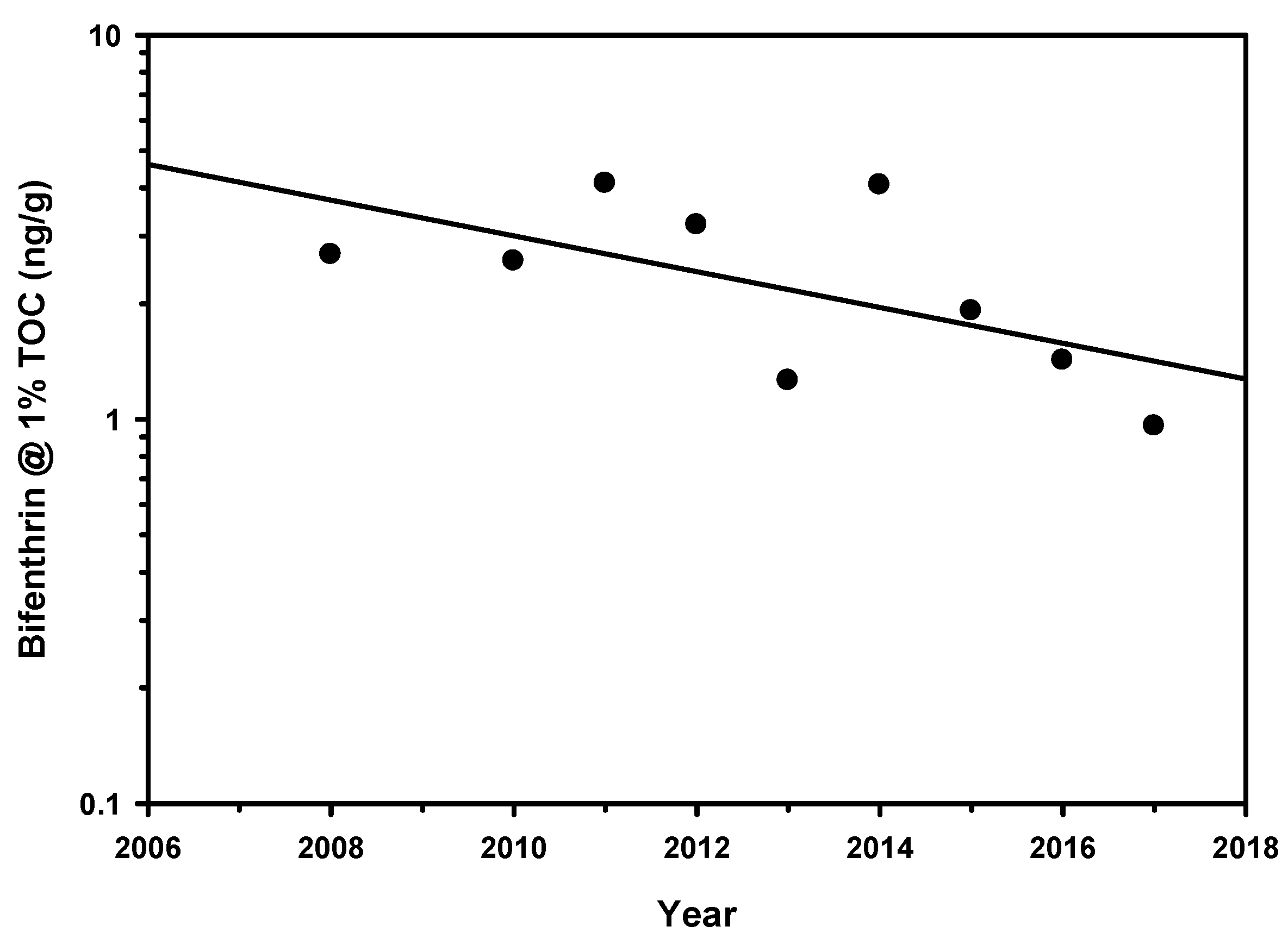
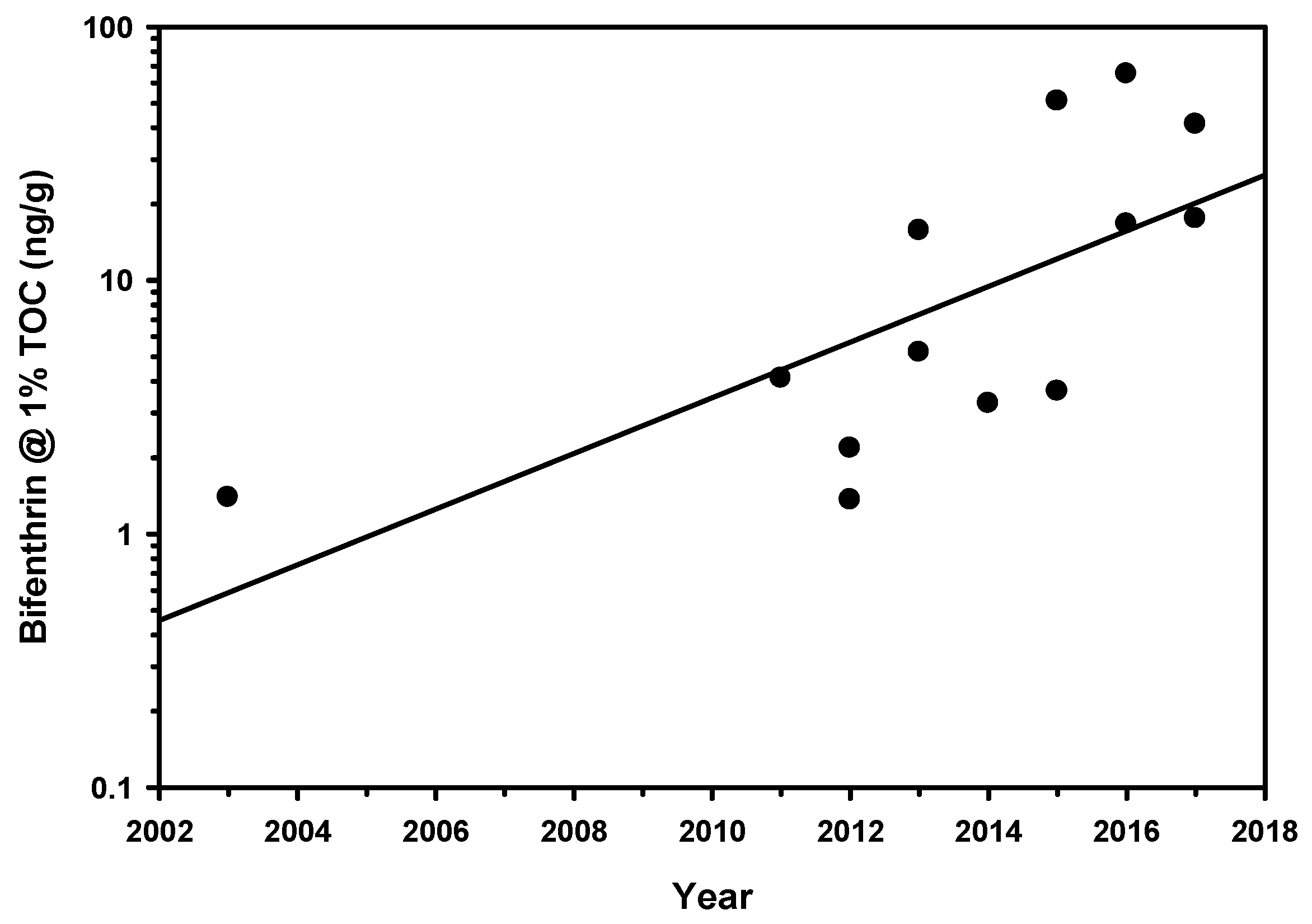
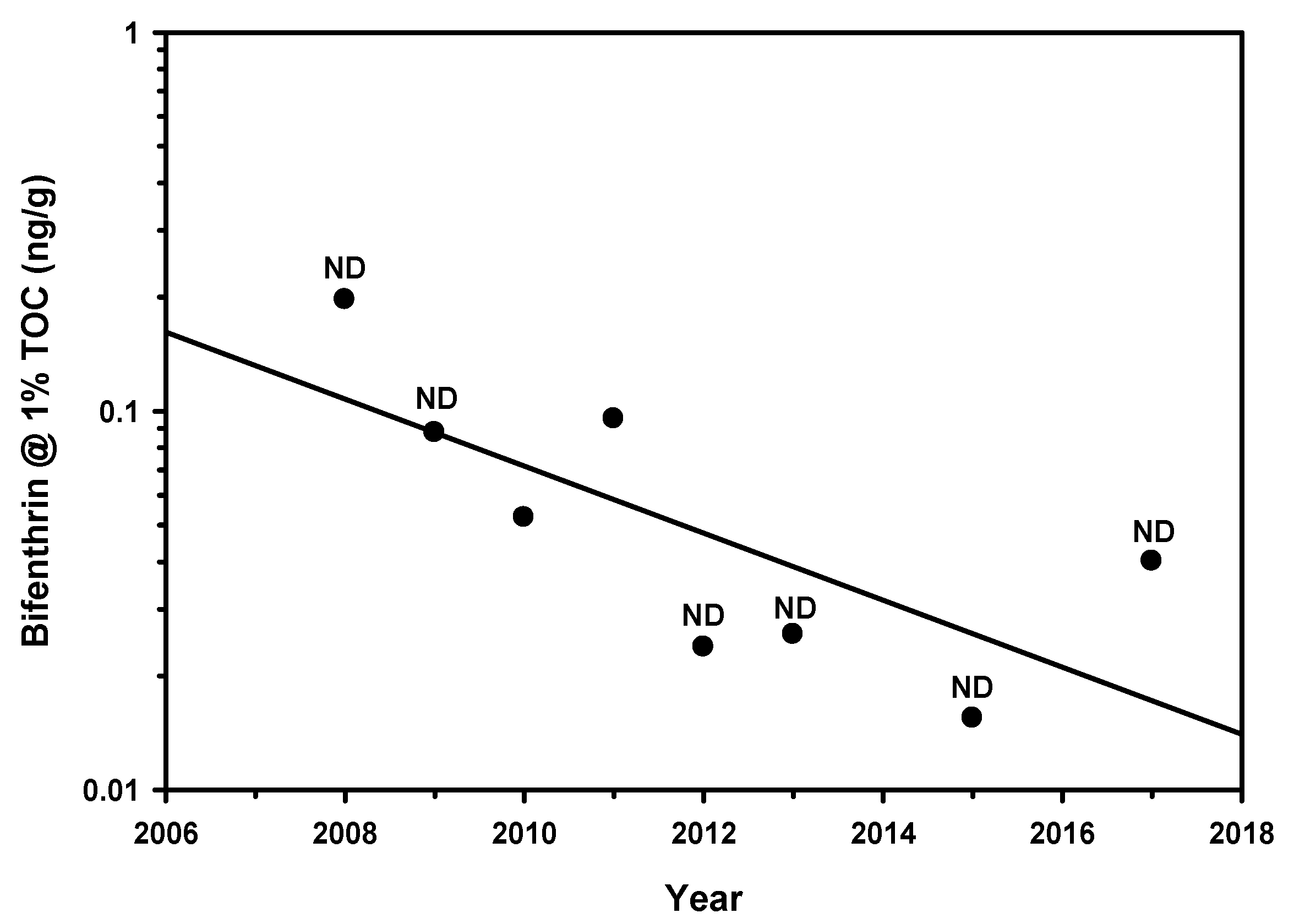
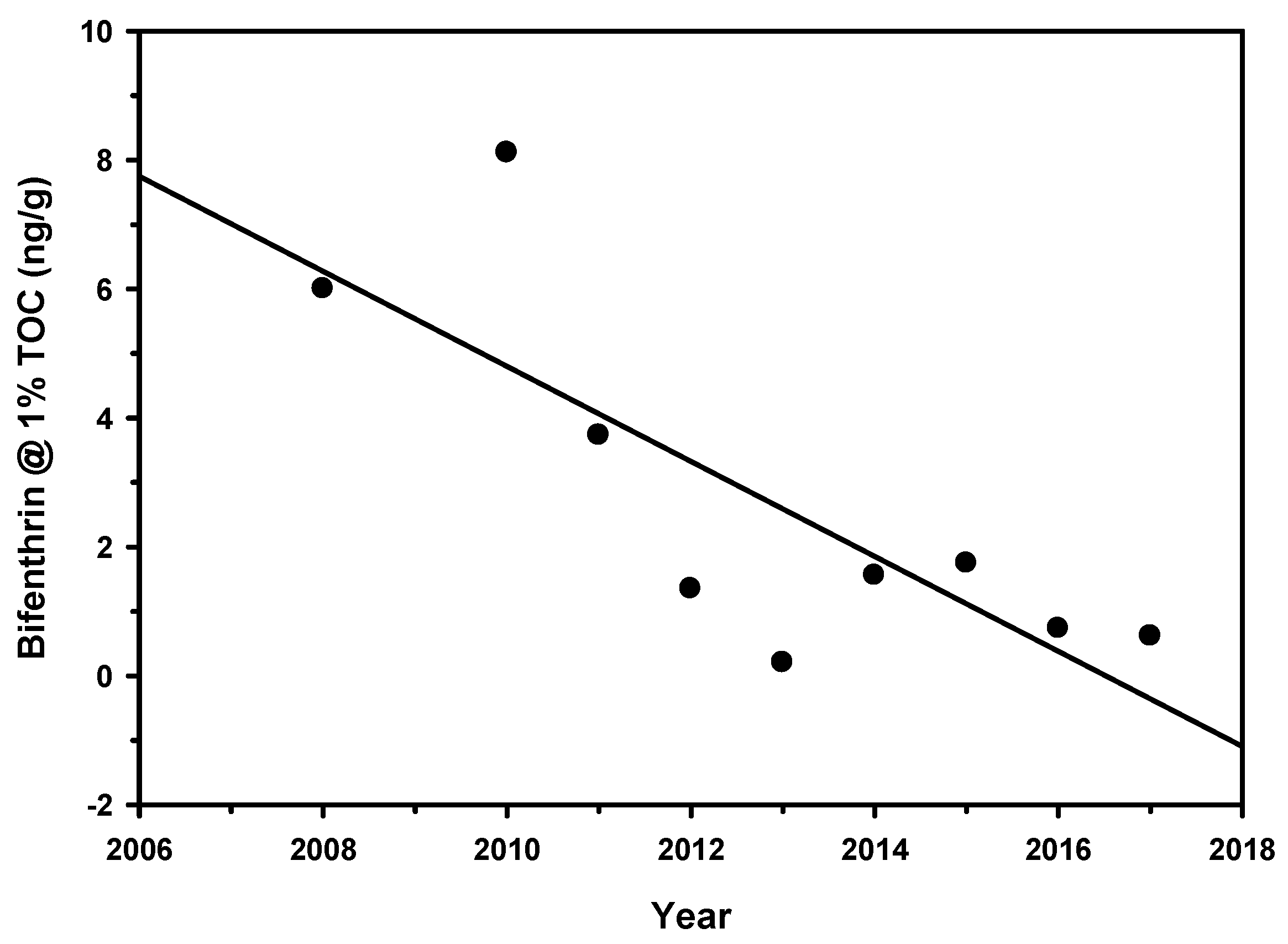
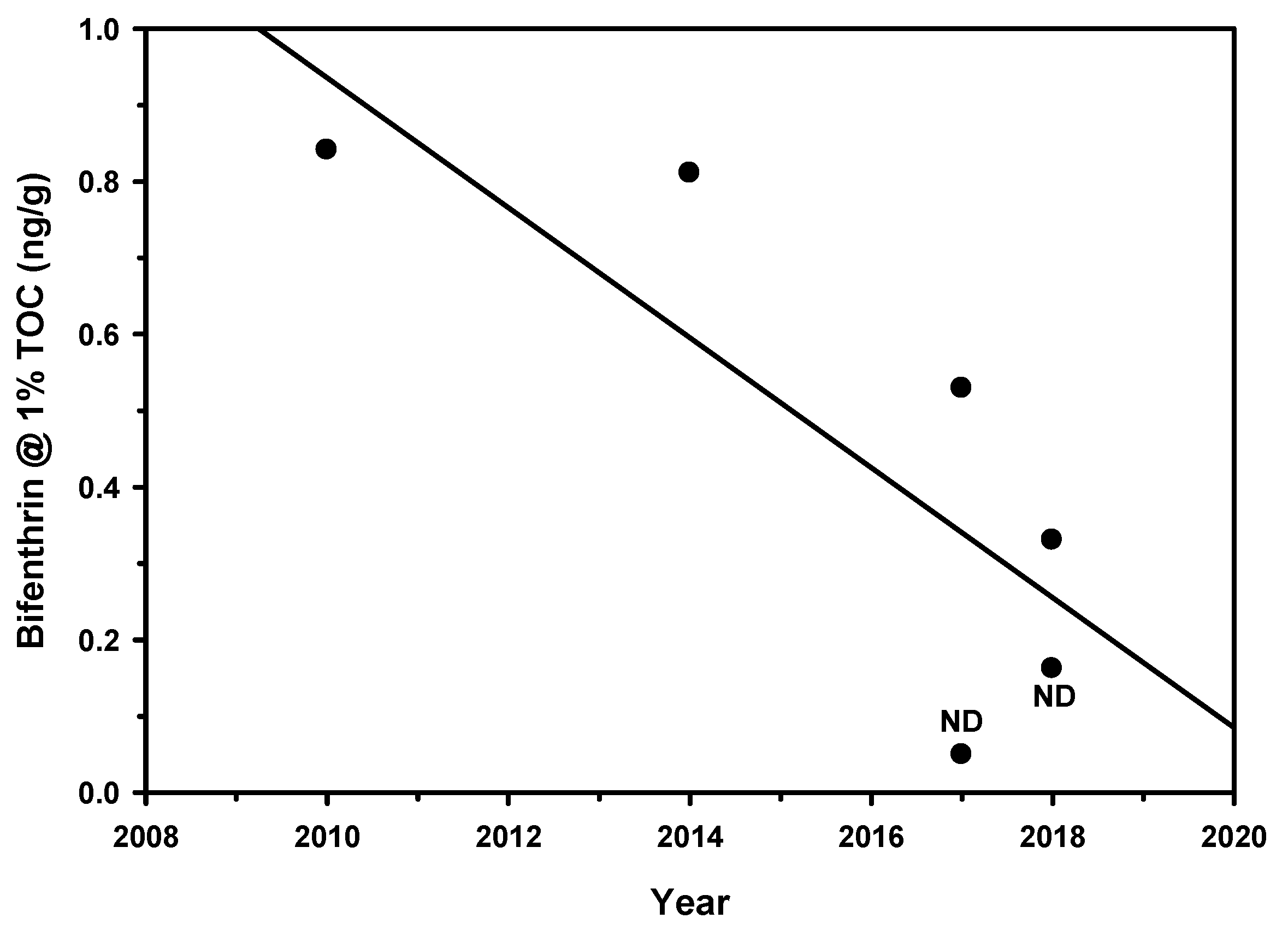


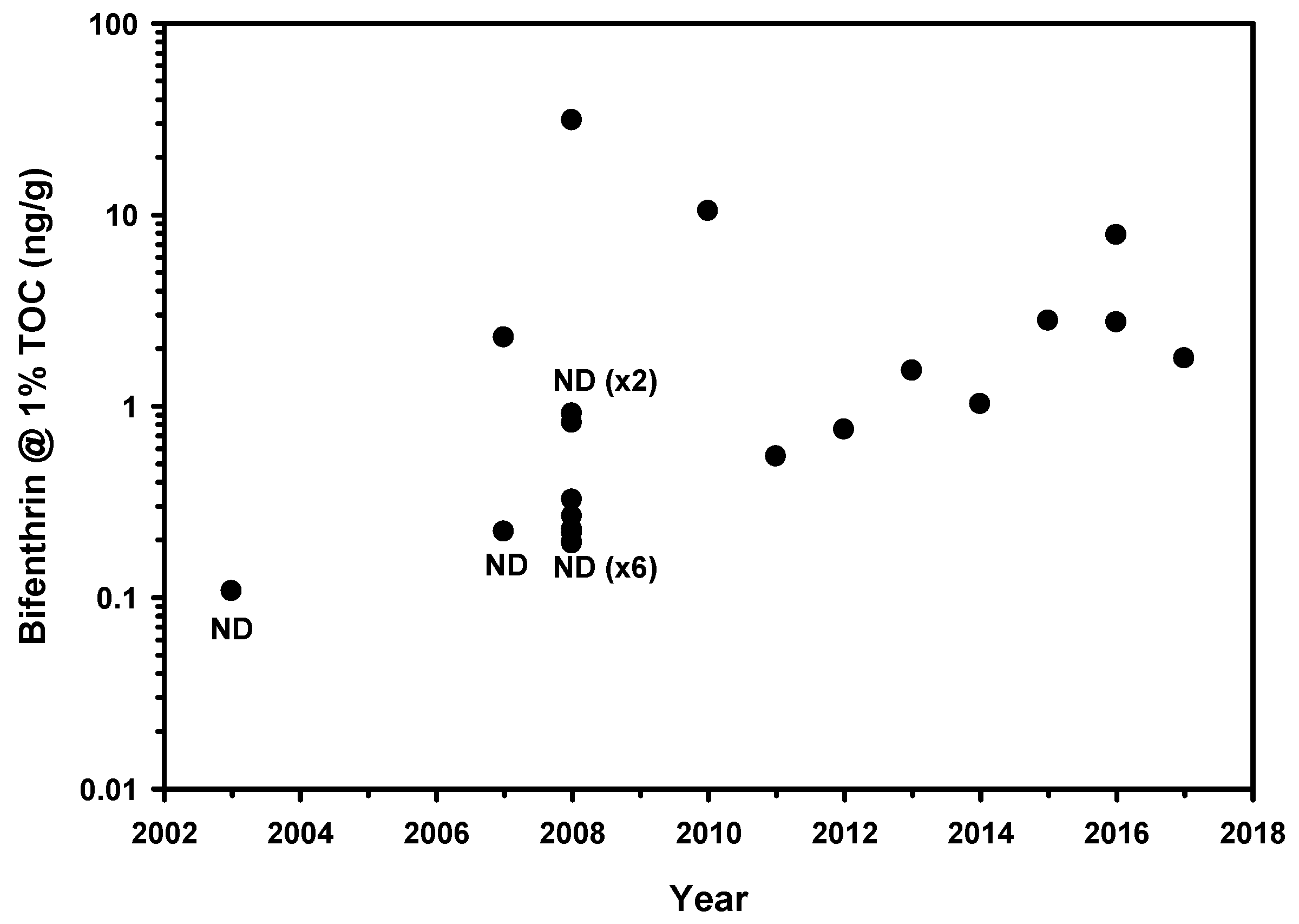


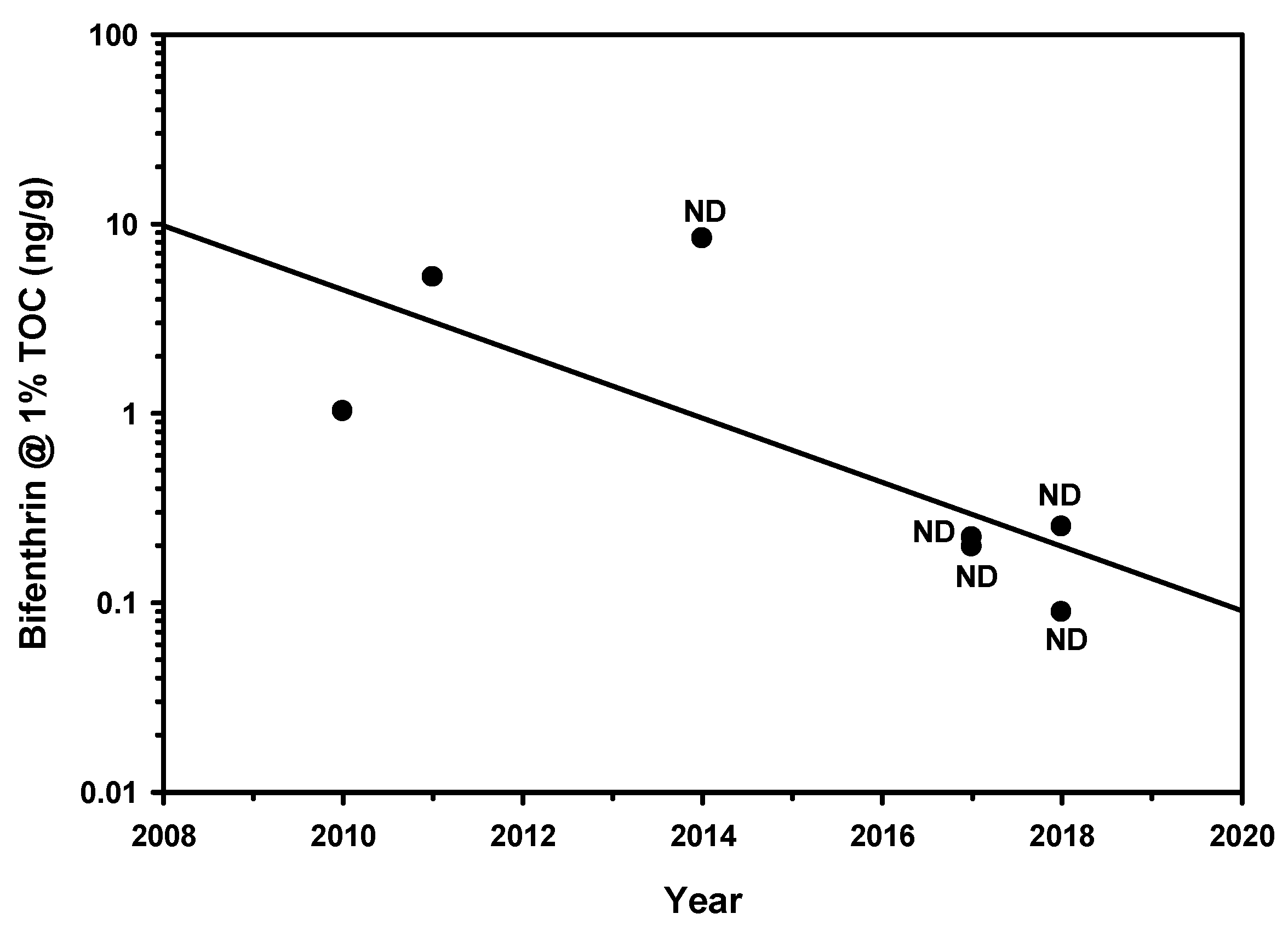
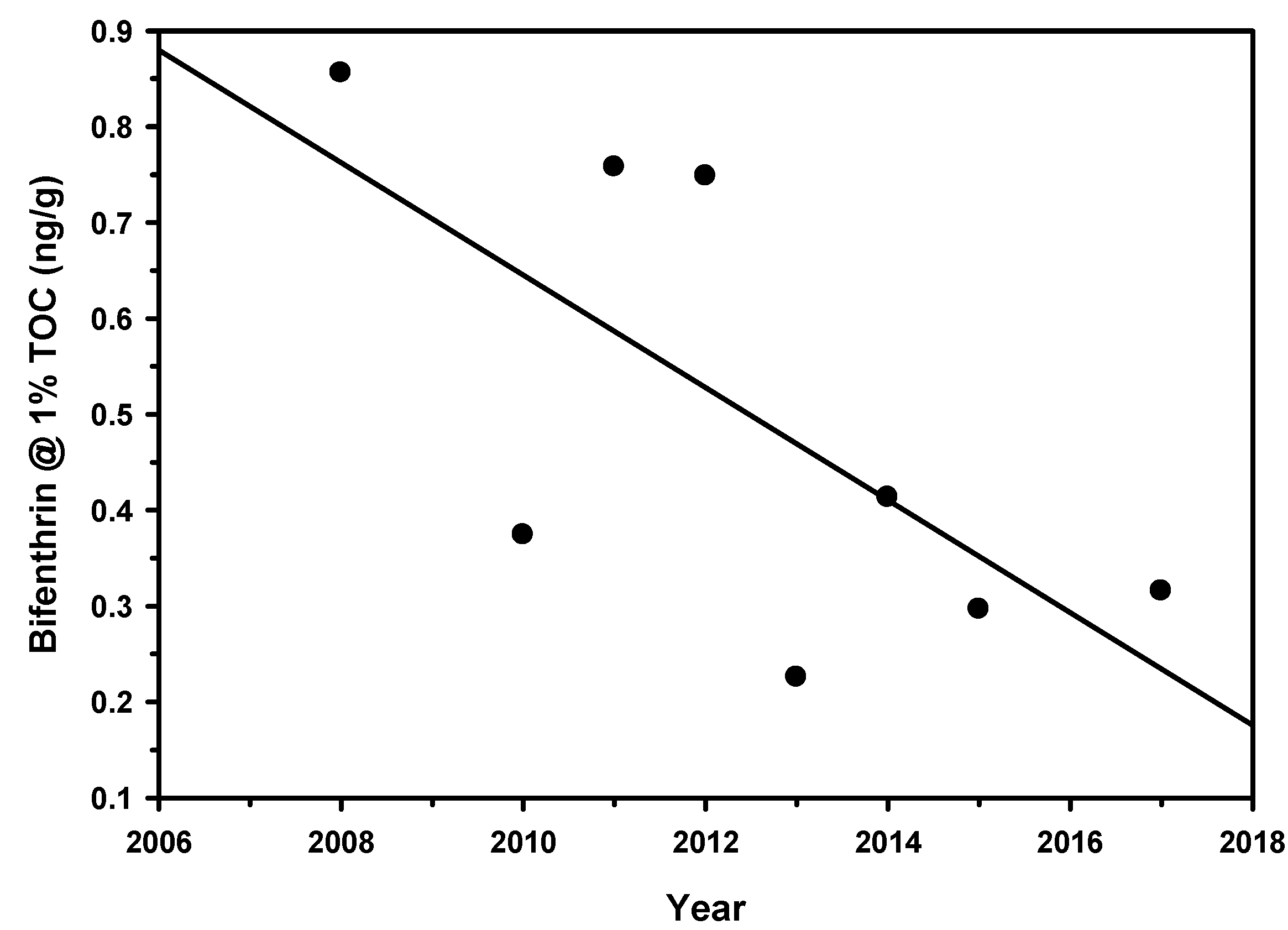
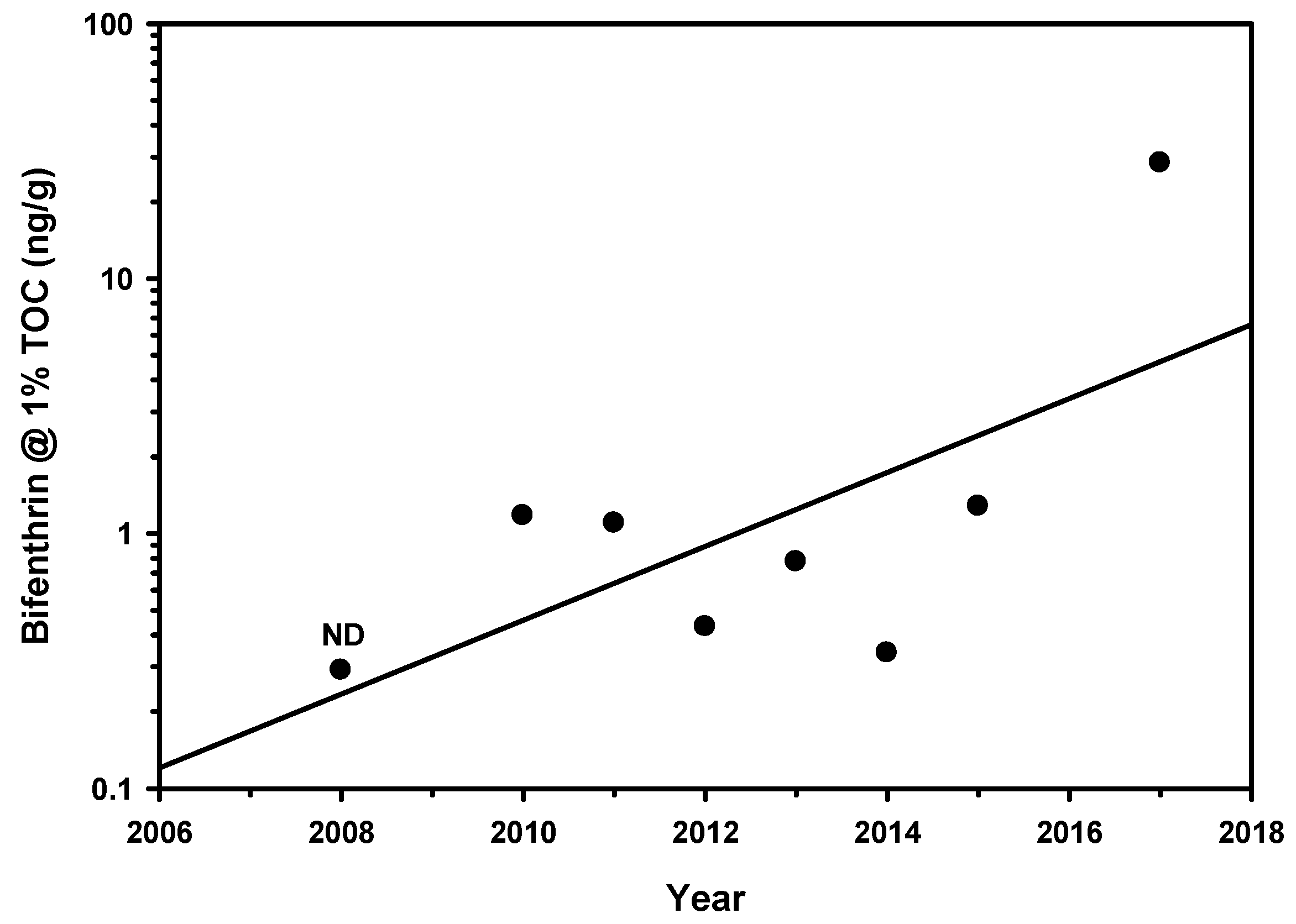
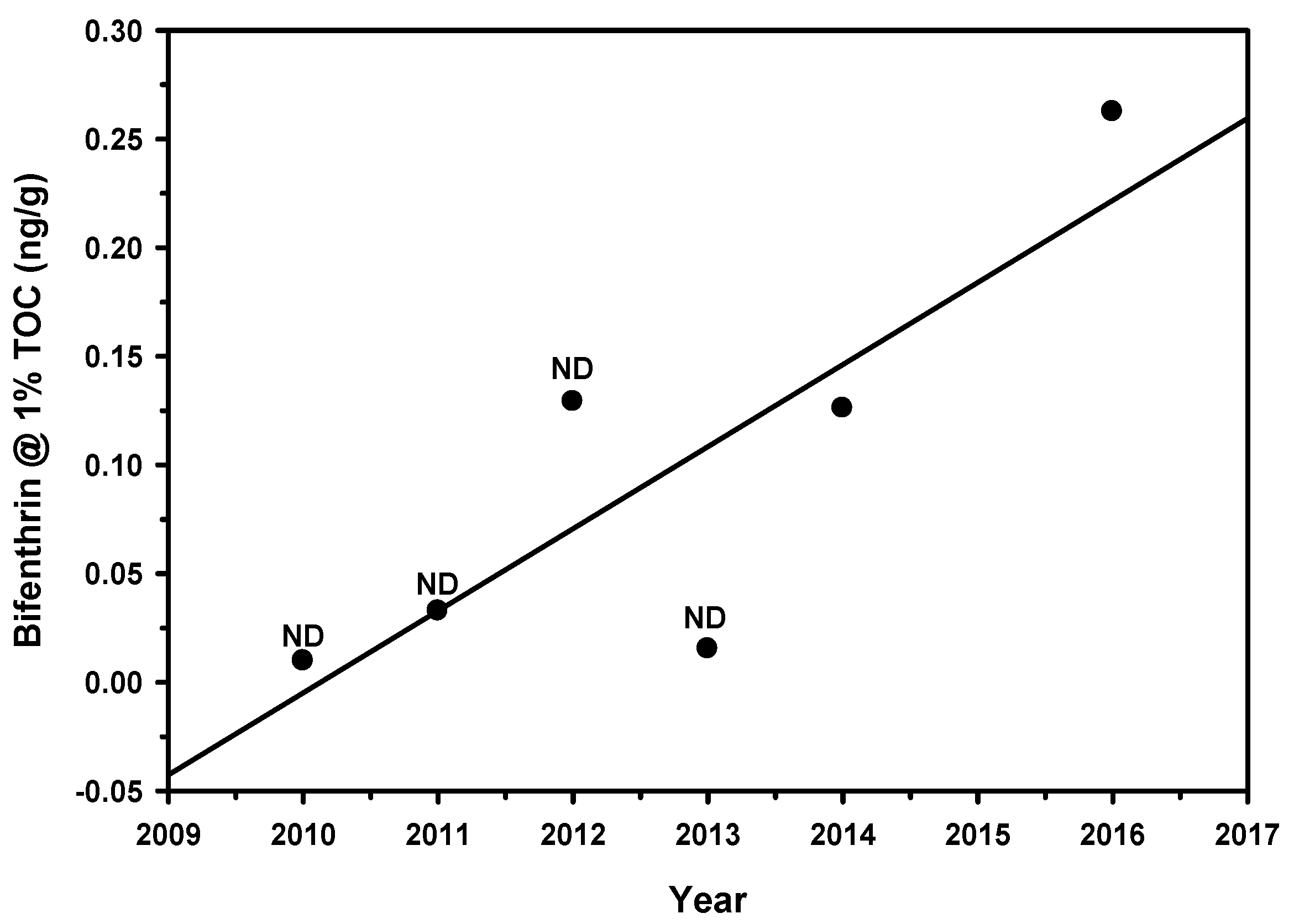
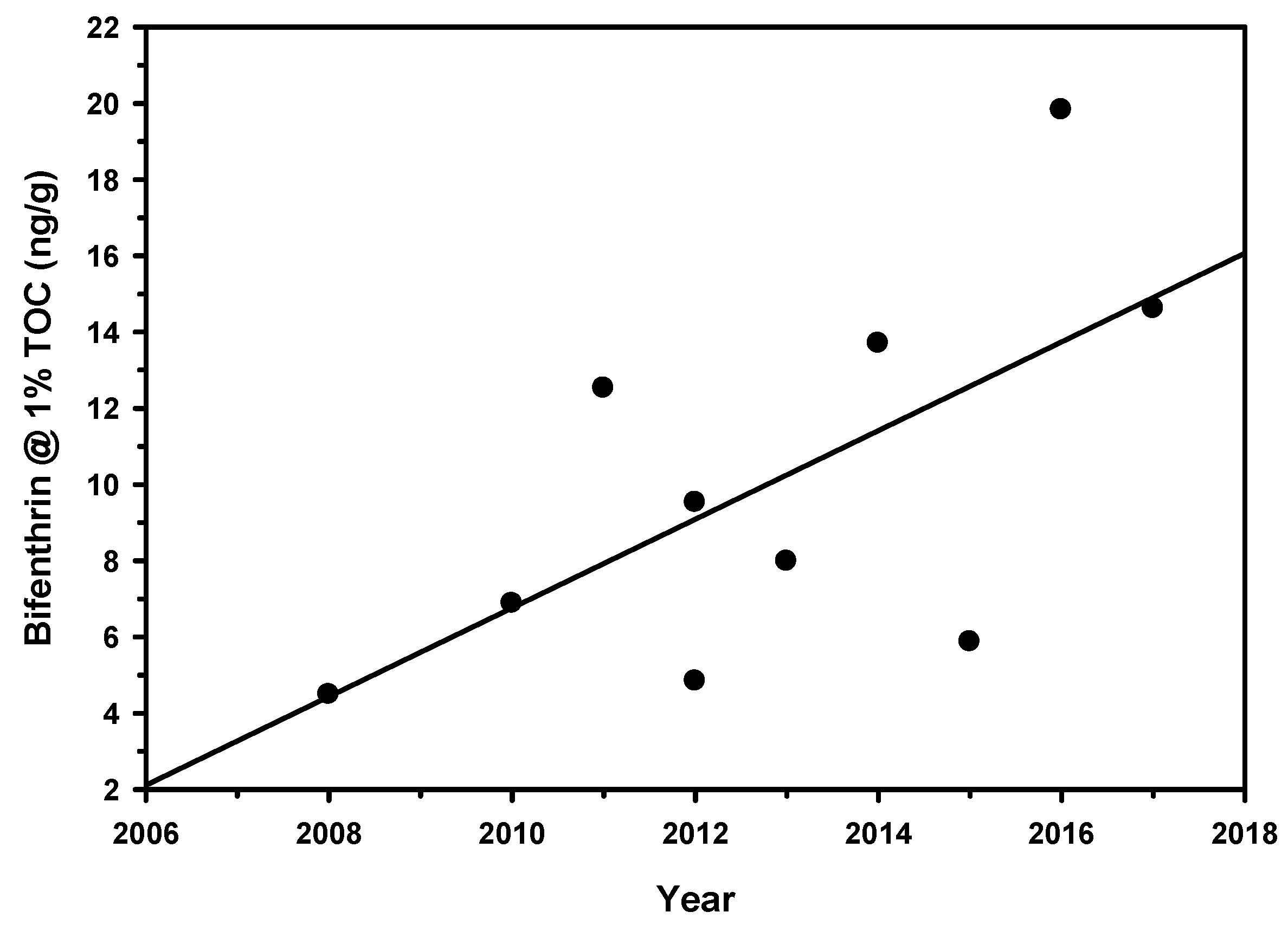

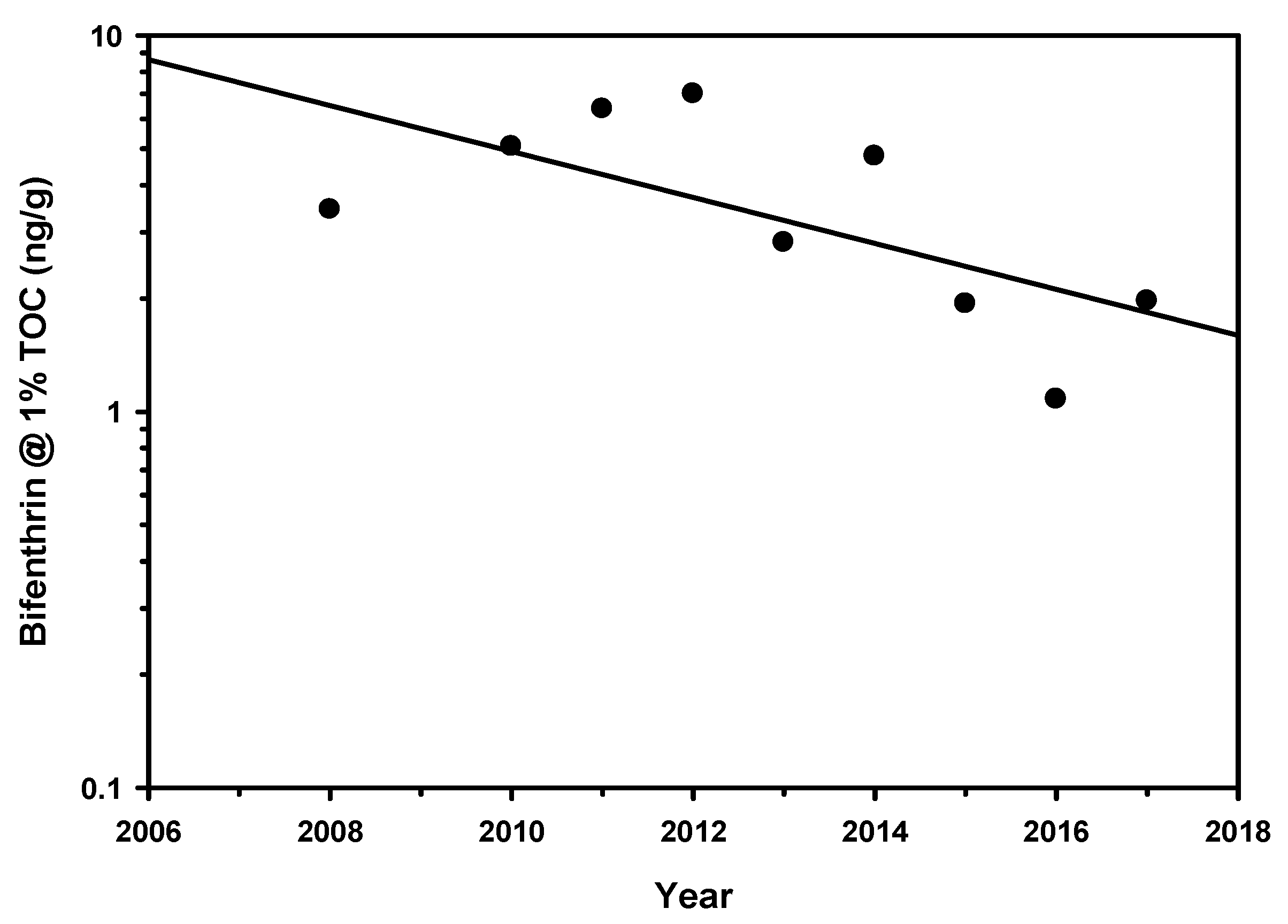
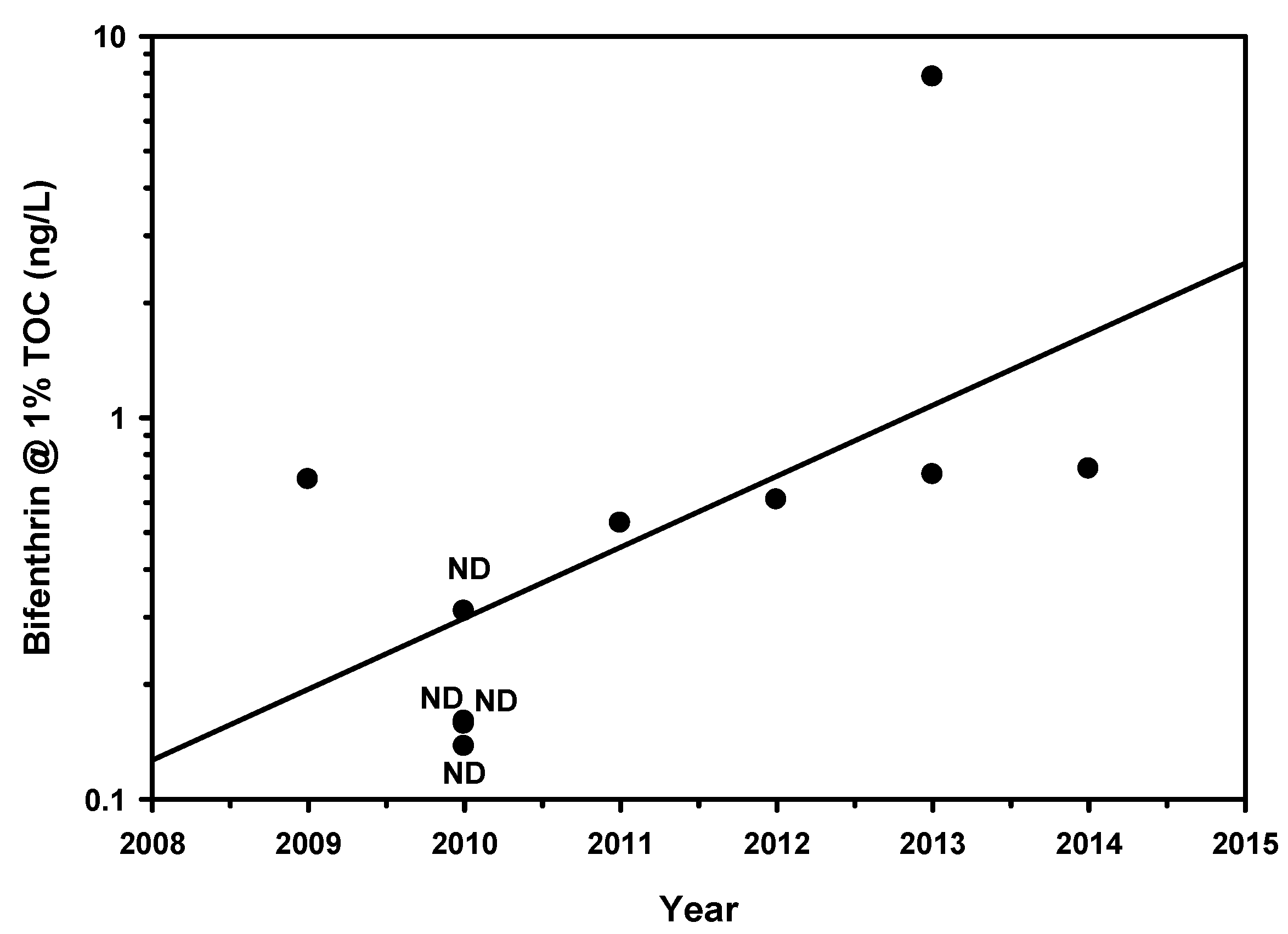
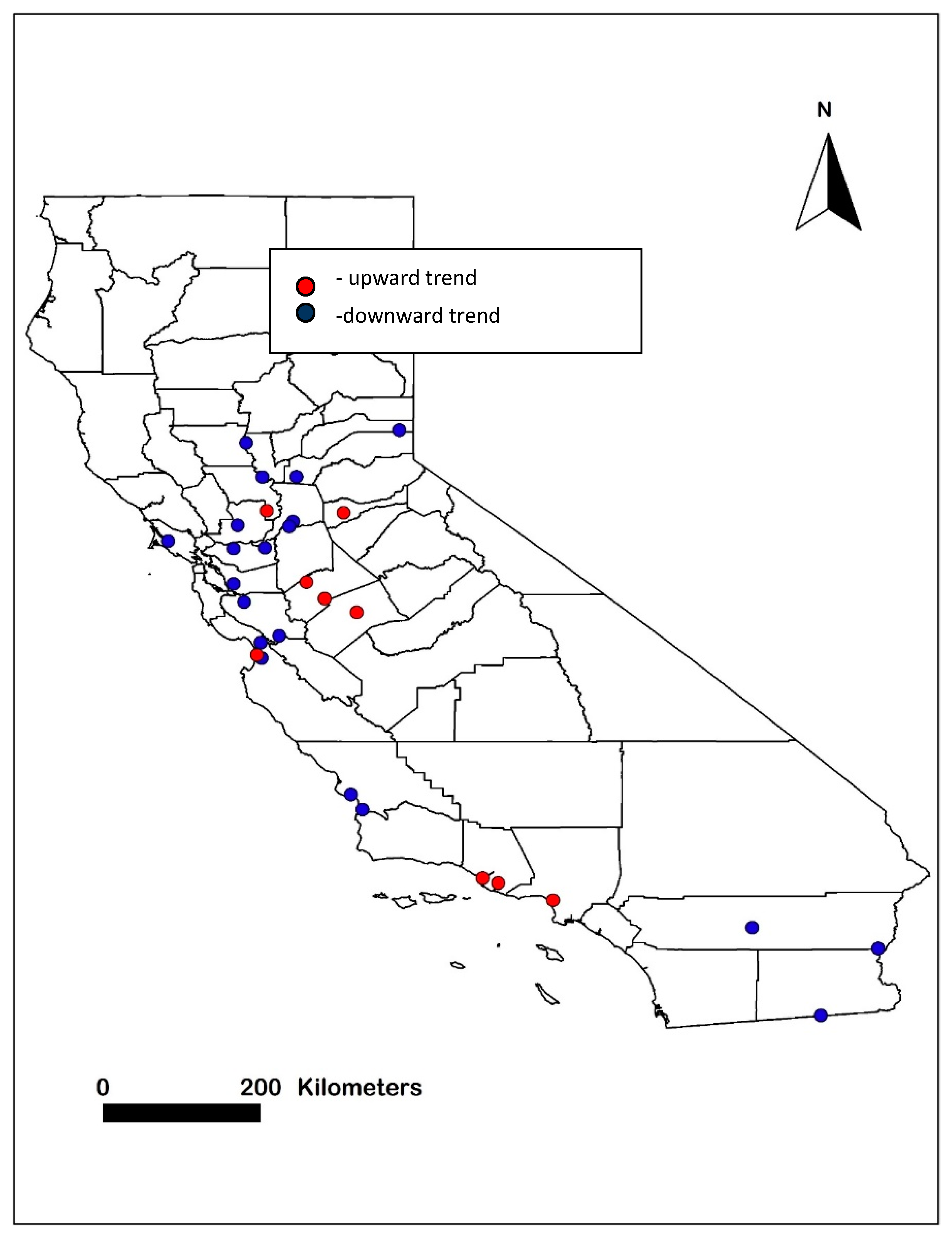
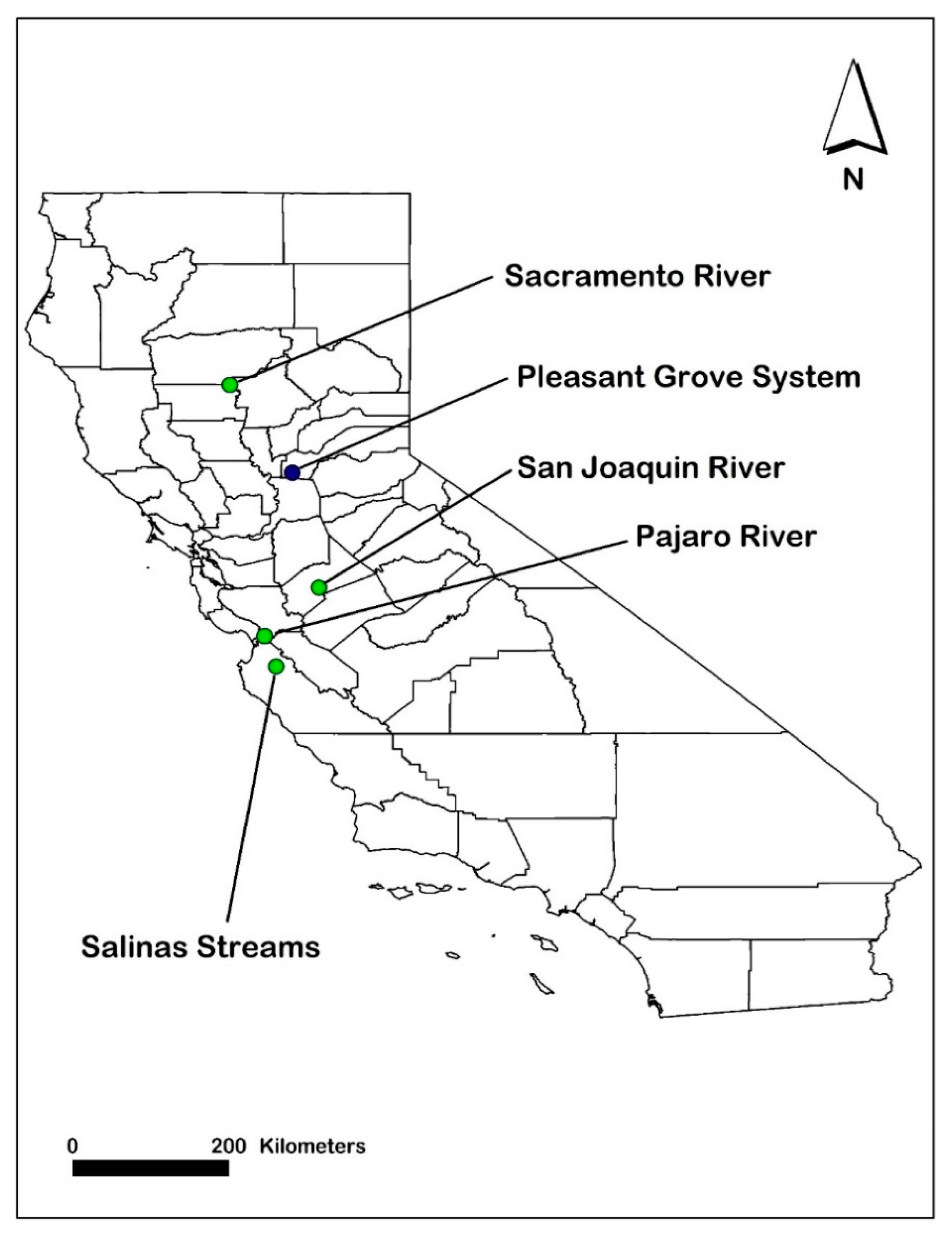

| Site Name | % | Land | Regression | Correlation | Trend | ||
|---|---|---|---|---|---|---|---|
| NDs | Use | r2 | p | r | p | Slope | |
| Alameda Creek E. of Alvarado Blvd | 0.0 | Urb | 0.773 | 0.004 | - | - | Down |
| Alamo River at International Boundary | 90.0 | Urb | - | - | −0.685 | 0.025 | Down |
| Ballona Creek Downstream of Sawtelle (Centinella) | 0.0 | Urb | 0.439 | 0.037 | - | - | Up |
| Bear Creek near Bert Crane Road | 14.3 | Agr | 0.835 | 0.004 | - | - | Up |
| Butte Slough upsteam of Pass Road Bridge | 0.0 | Agr | 0.612 | 0.038 | - | - | Down |
| Calleguas Creek Below Camrosa WWTP, Site 6 | 11.1 | Agr | 0.738 | 0.003 | - | - | Up |
| Coachella Valley Stormchannel (Ave 52) | 66.7 | Urb | 0.633 | 0.058 | - | - | Down |
| Colusa Basin Drain Upstream at Knights Landing | 0.0 | Agr | 0.524 | 0.066 | - | - | Down |
| Cosumnes River at Twin Cities Road | 12.5 | Agr | 0.391 | 0.097 | - | - | Down |
| Dual Storm Drain at Opal and Parkside Way b | 0.0 | Urb | 0.577 | 0.080 | - | - | Down |
| Espinosa Slough upstream of Alisal Slough | 0.0 | Agr | 0.792 | 0.007 | - | - | Down |
| Guadalupe Cr at USGS Gaging Station 11169025 | 0.0 | Urb | 0.362 | 0.086 | - | - | Down |
| Ingram Creek at River Road | 0.0 | Agr | 0.473 | 0.009 | - | - | Up |
| Lagunitus Creek at Coast Guard Station | 75.0 | Agr | 0.535 | 0.039 | - | - | Down |
| Laurel Creek at Pintail Drive | 0.0 | Urb | 0.626 | 0.011 | - | - | Down |
| Llagas Creek at Southside | 33.3 | Agr/Urb | 0.653 | 0.052 | - | - | Down |
| Marsh Creek at East Cypress Crossing | 0.0 | Agr/Urb | 0.468 | 0.029 | - | - | Down |
| Mokelumne River at New Hope Road | 0.0 | Agr | 0.721 | 0.032 | - | - | Down |
| Orestimba Creek at River Road | 47.6 | Agr | - | - | 0.577 | 0.006 | Up |
| Oso Flaco Creek at Oso Flaco Lake Road | 0.0 | Agr | 0.714 | 0.017 | - | - | Down |
| Palo Verde Lagoon (LG1) | 84.6 | Agr | 0.325 | 0.042 | - | - | Down |
| Salsipuedes Creek downstream of Corralitos Creek | 71.4 | Agr/Urb | 0.559 | 0.053 | - | - | Down |
| San Luis Obispo Creek at San Luis Bay Drive | 0.0 | Agr | 0.466 | 0.062 | - | - | Down |
| Santa Clara River Estuary | 12.5 | Agr/Urb | 0.439 | 0.074 | - | - | Up |
| Sutter Creek at Hwy 49 | 66.7 | Agr/Urb | 0.698 | 0.038 | - | - | Up |
| Tembladero Slough at Monterey Dunes Way | 0.0 | Agr | 0.416 | 0.044 | - | - | Up |
| Trout Creek (Truckee) near mouth | 33.3 | Agr | 0.677 | 0.044 | - | - | Down |
| Walnut Creek at Concord Ave O.C | 0.0 | Urb | 0.434 | 0.054 | - | - | Down |
| Z-Drain (Dixon RCD) | 40.0 | Agr | 0.376 | 0.059 | - | - | Up |
| Stream System Name | # of Sites Per | Primary | Regression | Trend | Sig. | |
|---|---|---|---|---|---|---|
| Stream System | Land Use | r2 | p | Slope | Trend | |
| Pajaro River | 4 | 0.013 | 0.752 | Up | No | |
| Pleasant Grove System b | 21 | Urban | 0.330 | 0.082 | Down | Yes |
| Sacramento River | 3 | 0.268 | 0.153 | Up | No | |
| Salinas Streams c | 17 | 0.082 | 0.365 | Up | No | |
| San Joaquin River | 3 | 0.145 | 0.399 | Down | No | |
© 2020 by the authors. Licensee MDPI, Basel, Switzerland. This article is an open access article distributed under the terms and conditions of the Creative Commons Attribution (CC BY) license (http://creativecommons.org/licenses/by/4.0/).
Share and Cite
Hall, L.W., Jr.; Anderson, R.D. An Eighteen Year Temporal Trends Analysis of Bifenthrin Sediment Concentrations in California Waterbodies. Water 2020, 12, 2402. https://doi.org/10.3390/w12092402
Hall LW Jr., Anderson RD. An Eighteen Year Temporal Trends Analysis of Bifenthrin Sediment Concentrations in California Waterbodies. Water. 2020; 12(9):2402. https://doi.org/10.3390/w12092402
Chicago/Turabian StyleHall, Lenwood W., Jr., and Ronald D. Anderson. 2020. "An Eighteen Year Temporal Trends Analysis of Bifenthrin Sediment Concentrations in California Waterbodies" Water 12, no. 9: 2402. https://doi.org/10.3390/w12092402




